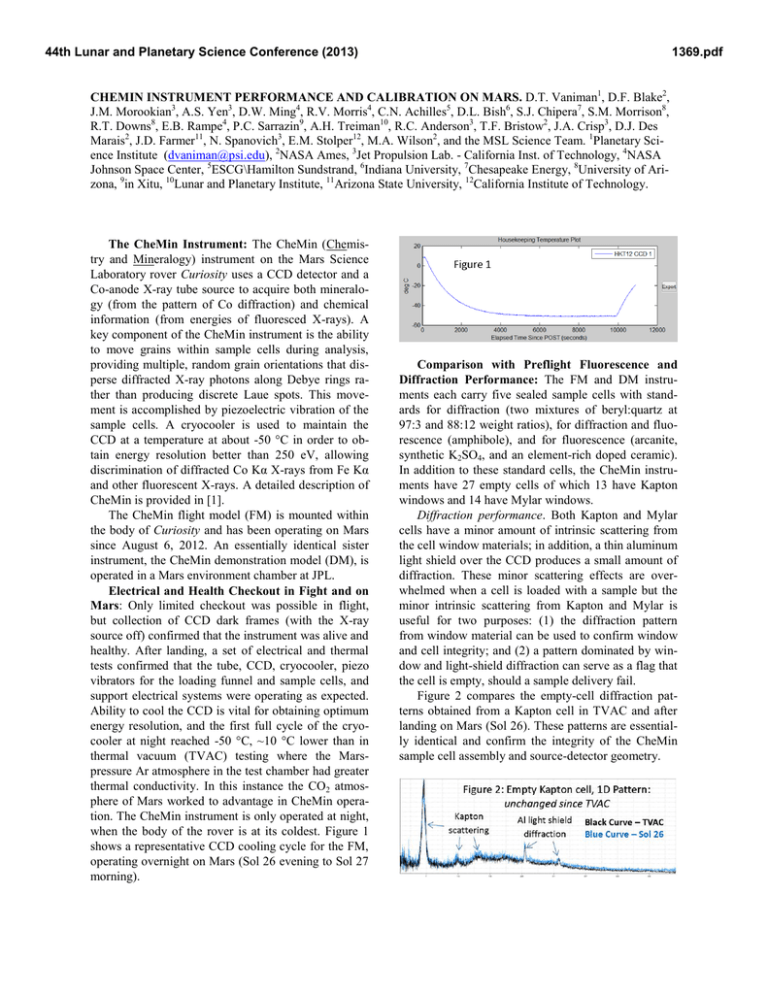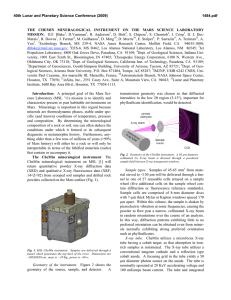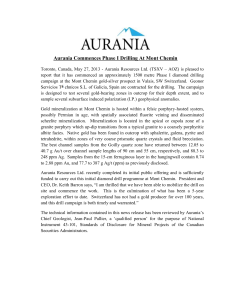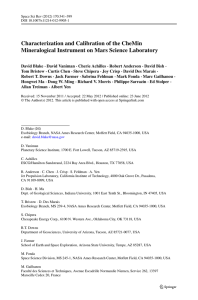CHEMIN INSTRUMENT PERFORMANCE AND CALIBRATION ON MARS. , D.F. Blake , J.M. Morookian
advertisement

44th Lunar and Planetary Science Conference (2013) 1369.pdf CHEMIN INSTRUMENT PERFORMANCE AND CALIBRATION ON MARS. D.T. Vaniman1, D.F. Blake2, J.M. Morookian3, A.S. Yen3, D.W. Ming4, R.V. Morris4, C.N. Achilles5, D.L. Bish6, S.J. Chipera7, S.M. Morrison8, R.T. Downs8, E.B. Rampe4, P.C. Sarrazin9, A.H. Treiman10, R.C. Anderson3, T.F. Bristow2, J.A. Crisp3, D.J. Des Marais2, J.D. Farmer11, N. Spanovich3, E.M. Stolper12, M.A. Wilson2, and the MSL Science Team. 1Planetary Science Institute (dvaniman@psi.edu), 2NASA Ames, 3Jet Propulsion Lab. - California Inst. of Technology, 4NASA Johnson Space Center, 5ESCG\Hamilton Sundstrand, 6Indiana University, 7Chesapeake Energy, 8University of Arizona, 9in Xitu, 10Lunar and Planetary Institute, 11Arizona State University, 12California Institute of Technology. The CheMin Instrument: The CheMin (Chemistry and Mineralogy) instrument on the Mars Science Laboratory rover Curiosity uses a CCD detector and a Co-anode X-ray tube source to acquire both mineralogy (from the pattern of Co diffraction) and chemical information (from energies of fluoresced X-rays). A key component of the CheMin instrument is the ability to move grains within sample cells during analysis, providing multiple, random grain orientations that disperse diffracted X-ray photons along Debye rings rather than producing discrete Laue spots. This movement is accomplished by piezoelectric vibration of the sample cells. A cryocooler is used to maintain the CCD at a temperature at about -50 °C in order to obtain energy resolution better than 250 eV, allowing discrimination of diffracted Co Kα X-rays from Fe Kα and other fluorescent X-rays. A detailed description of CheMin is provided in [1]. The CheMin flight model (FM) is mounted within the body of Curiosity and has been operating on Mars since August 6, 2012. An essentially identical sister instrument, the CheMin demonstration model (DM), is operated in a Mars environment chamber at JPL. Electrical and Health Checkout in Fight and on Mars: Only limited checkout was possible in flight, but collection of CCD dark frames (with the X-ray source off) confirmed that the instrument was alive and healthy. After landing, a set of electrical and thermal tests confirmed that the tube, CCD, cryocooler, piezo vibrators for the loading funnel and sample cells, and support electrical systems were operating as expected. Ability to cool the CCD is vital for obtaining optimum energy resolution, and the first full cycle of the cryocooler at night reached -50 °C, ~10 °C lower than in thermal vacuum (TVAC) testing where the Marspressure Ar atmosphere in the test chamber had greater thermal conductivity. In this instance the CO2 atmosphere of Mars worked to advantage in CheMin operation. The CheMin instrument is only operated at night, when the body of the rover is at its coldest. Figure 1 shows a representative CCD cooling cycle for the FM, operating overnight on Mars (Sol 26 evening to Sol 27 morning). Comparison with Preflight Fluorescence and Diffraction Performance: The FM and DM instruments each carry five sealed sample cells with standards for diffraction (two mixtures of beryl:quartz at 97:3 and 88:12 weight ratios), for diffraction and fluorescence (amphibole), and for fluorescence (arcanite, synthetic K2SO4, and an element-rich doped ceramic). In addition to these standard cells, the CheMin instruments have 27 empty cells of which 13 have Kapton windows and 14 have Mylar windows. Diffraction performance. Both Kapton and Mylar cells have a minor amount of intrinsic scattering from the cell window materials; in addition, a thin aluminum light shield over the CCD produces a small amount of diffraction. These minor scattering effects are overwhelmed when a cell is loaded with a sample but the minor intrinsic scattering from Kapton and Mylar is useful for two purposes: (1) the diffraction pattern from window material can be used to confirm window and cell integrity; and (2) a pattern dominated by window and light-shield diffraction can serve as a flag that the cell is empty, should a sample delivery fail. Figure 2 compares the empty-cell diffraction patterns obtained from a Kapton cell in TVAC and after landing on Mars (Sol 26). These patterns are essentially identical and confirm the integrity of the CheMin sample cell assembly and source-detector geometry. 44th Lunar and Planetary Science Conference (2013) Fluorescence performance. X-ray fluorescence data from the CheMin CCD are effective for elements heavier than Si; X-ray photon energies for elements lighter than Si are not effectively measured. Fluorescence data can be used to supplement diffraction data in phase identification. A key parameter in fluorescence performance is the ability to differentiate diffracted Co Kα X-rays from fluoresced Fe Kα, particularly in Fe-rich materials common on Mars. For this purpose, design requirements for CheMin energy resolution included a maximum FWHM of 250 eV at Co Kα. Analyses with the CheMin FM on Mars attained a Co Kα FWHM of 225 eV, well within required energy resolution. Figure 3 compares an empty-cell energy plot from Sol 32 with the data from analysis of the Rocknest eolian sample analyzed on Sol 71. Energy separation of Co Kα from Fe Kα in the Rocknest sample is clearly shown, as well as fluorescence contributions from Ca, Ti, Cr, and Mn in the eolian sample. Data collection modes: The vibration modes developed in CheMin design include a basic level of vibration during analysis to keep grains moving through the X-ray beam in an eddy cycle, punctuated by short and long periods of more intense vibration that can remix grains in the sample. These more intense vibrations (“chaos mode”) remix samples that may segregate on the basis of density, shape, agglomeration, or other factors. The CheMin FM was operated in TVAC with maximum setting for the short chaos cycle. However, in TVAC no samples in open cells were similarly tested because of the need to keep all sample cells in pristine condition before accepting samples on Mars. Only the five sealed cells containing standards were analyzed before flight. On Mars, the first sample analyzed consisted of fine sand and silt scooped from the Rocknest eolian bedform. That sample moved so vigorously under this vibration mode that material was lost from the top of the cell during analysis. Tests were run in the DM to determine whether granular samples such as this would move in the cell when an adjacent cell pair 1369.pdf was vibrated, rather than using direct vibration of the cell pair containing the sample. This ‘adjacent vibration’ or ‘kumbayatic’ analysis mode was first tested in the DM; use of this mode was then used effectively on Mars with subsequent Rocknest analyses. Extended Ccalibration and Performance Confirmation: In the extended multi-year lifetime of Curiosity it is expected that CCD performance in CheMin will slowly degrade as a result of aging of the cryocooler and accumulated damage from GCR and neutrons from Curiosity’s RTG. Performance will be tracked through use of the five internal standards. In addition, performance can be tracked in a “running confirmation” of alignment based on phases of opportunity with relatively fixed and accepted cell parameters (e.g., anhydrite, kieserite, crystalline silica polymorphs). Although performance may diminish, collection of acceptable data can be maintained by shortening CCD collection times and limiting readout to the central part of the CCD. The CheMin demonstration model (DM): The CheMin demonstration model (DM) is shown in Figure 4, within a Mars chamber at JPL that can maintain a Mars-like CO2 atmosphere. All components of the FM, including the top funnel through which samples are delivered, are replicated in the FM except for the outer case and a small sump at the bottom that collects discarded samples. The DM is being used to test an extended suite of known samples, unknown test samples, and modes of operation. The DM will also be available to examine and work through issues that may arise with operation of the FM on Mars. Acknowledgment: We thank the NASA Mars Science Laboratory Program for supporting CheMin instrument development and operation. References: [1] Blake D. et al. (2012) Space Sci. Rev. doi: 10.1007/s11214-012-9905-1.







